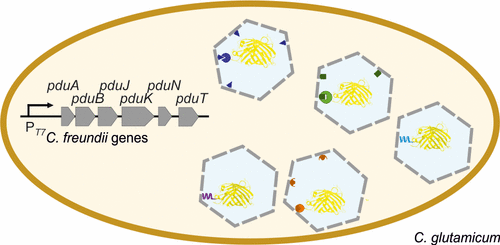当前位置:
X-MOL 学术
›
ACS Synth. Biol.
›
论文详情
Our official English website, www.x-mol.net, welcomes your feedback! (Note: you will need to create a separate account there.)
Construction of Recombinant Pdu Metabolosome Shells for Small Molecule Production in Corynebacterium glutamicum
ACS Synthetic Biology ( IF 4.7 ) Pub Date : 2017-09-01 00:00:00 , DOI: 10.1021/acssynbio.7b00167 Isabel Huber 1 , David J. Palmer 2 , Kira N. Ludwig 1 , Ian R. Brown 2 , Martin J. Warren 2 , Julia Frunzke 1
ACS Synthetic Biology ( IF 4.7 ) Pub Date : 2017-09-01 00:00:00 , DOI: 10.1021/acssynbio.7b00167 Isabel Huber 1 , David J. Palmer 2 , Kira N. Ludwig 1 , Ian R. Brown 2 , Martin J. Warren 2 , Julia Frunzke 1
Affiliation

|
Bacterial microcompartments have significant potential in the area of industrial biotechnology for the production of small molecules, especially involving metabolic pathways with toxic or volatile intermediates. Corynebacterium glutamicum is an established industrial workhorse for the production of amino acids and has been investigated for the production of diamines, dicarboxylic acids, polymers and biobased fuels. Herein, we describe components for the establishment of bacterial microcompartments as production chambers in C. glutamicum. Within this study, we optimized genetic clusters for the expression of the shell components of the Citrobacter freundii propanediol utilization (Pdu) bacterial compartment, thereby facilitating heterologous compartment production in C. glutamicum. Upon induction, transmission electron microscopy images of thin sections from these strains revealed microcompartment-like structures within the cytosol. Furthermore, we demonstrate that it is possible to target eYFP to the empty microcompartments through C-terminal fusions with synthetic scaffold interaction partners (PDZ, SH3 and GBD) as well as with a non-native C-terminal targeting peptide from AdhDH (Klebsiella pneumonia). Thus, we show that it is possible to target proteins to compartments where N-terminal targeting is not possible. The overproduction of PduA alone leads to the construction of filamentous structures within the cytosol and eYFP molecules are localized to these structures when they are N-terminally fused to the P18 and D18 encapsulation peptides from PduP and PduD, respectively. In the future, these nanotube-like structures might be used as scaffolds for directed cellular organization and pathway enhancement.
中文翻译:

谷氨酸棒状杆菌小分子生产重组Pdu代谢组壳的构建
细菌微区室在工业生物技术领域中具有生产小分子的巨大潜力,特别是涉及具有毒性或挥发性中间体的代谢途径。谷氨酸棒杆菌是用于生产氨基酸的成熟工业用马,并且已经被研究用于生产二胺,二羧酸,聚合物和生物基燃料。在本文中,我们描述了用于建立谷氨酸棒杆菌生产室的细菌微区室的组件。在这项研究中,我们优化了遗传簇以表达弗氏柠檬酸杆菌的壳成分丙二醇利用(Pdu)细菌区室,从而促进谷氨酸棒杆菌中异源区室的产生。诱导后,来自这些菌株的薄切片的透射电子显微镜图像显示了胞质溶胶中的微隔室样结构。此外,我们证明有可能通过与合成支架相互作用伴侣(PDZ,SH3和GBD)以及来自AdhDH的非天然C末端靶向肽的C端融合,将eYFP靶向空的微区室(克雷伯菌肺炎)。因此,我们表明有可能将蛋白质靶向不可能进行N末端靶向的区室。仅PduA的过量生产会导致胞质溶胶中的丝状结构的构建,并且当eYFP分子分别在N端与来自PduP和PduD的P18和D18包封肽融合时,会定位在这些结构上。将来,这些类似纳米管的结构可能会被用作定向细胞组织和途径增强的支架。
更新日期:2017-09-04
中文翻译:

谷氨酸棒状杆菌小分子生产重组Pdu代谢组壳的构建
细菌微区室在工业生物技术领域中具有生产小分子的巨大潜力,特别是涉及具有毒性或挥发性中间体的代谢途径。谷氨酸棒杆菌是用于生产氨基酸的成熟工业用马,并且已经被研究用于生产二胺,二羧酸,聚合物和生物基燃料。在本文中,我们描述了用于建立谷氨酸棒杆菌生产室的细菌微区室的组件。在这项研究中,我们优化了遗传簇以表达弗氏柠檬酸杆菌的壳成分丙二醇利用(Pdu)细菌区室,从而促进谷氨酸棒杆菌中异源区室的产生。诱导后,来自这些菌株的薄切片的透射电子显微镜图像显示了胞质溶胶中的微隔室样结构。此外,我们证明有可能通过与合成支架相互作用伴侣(PDZ,SH3和GBD)以及来自AdhDH的非天然C末端靶向肽的C端融合,将eYFP靶向空的微区室(克雷伯菌肺炎)。因此,我们表明有可能将蛋白质靶向不可能进行N末端靶向的区室。仅PduA的过量生产会导致胞质溶胶中的丝状结构的构建,并且当eYFP分子分别在N端与来自PduP和PduD的P18和D18包封肽融合时,会定位在这些结构上。将来,这些类似纳米管的结构可能会被用作定向细胞组织和途径增强的支架。


























 京公网安备 11010802027423号
京公网安备 11010802027423号